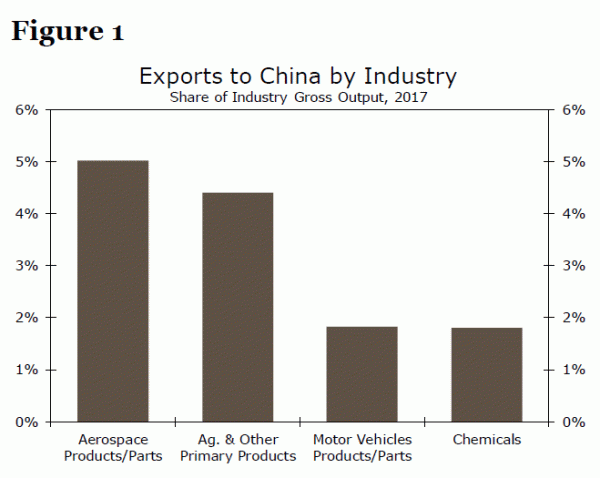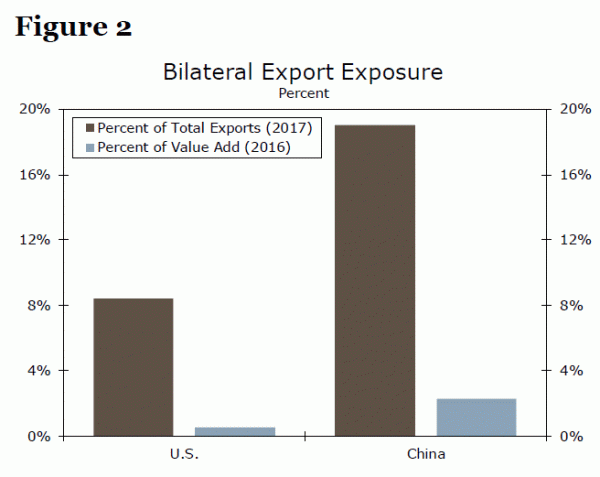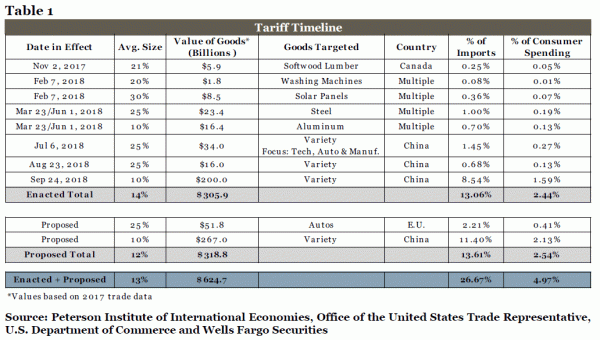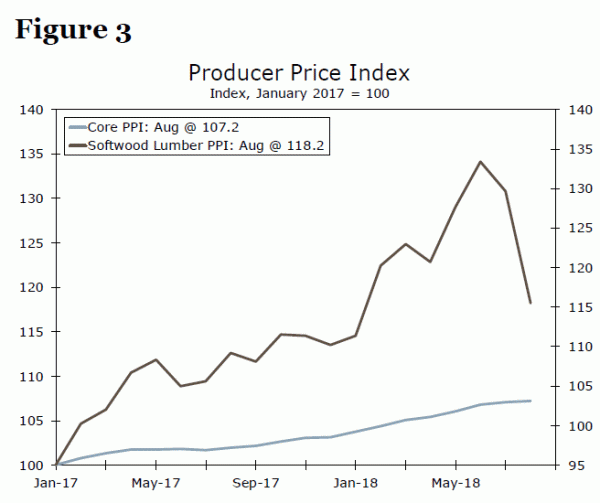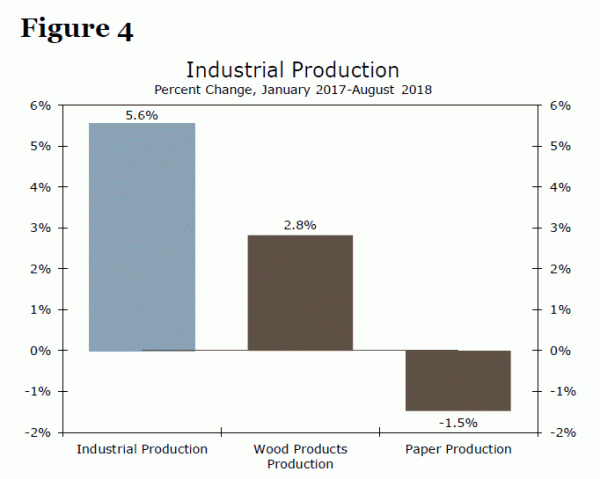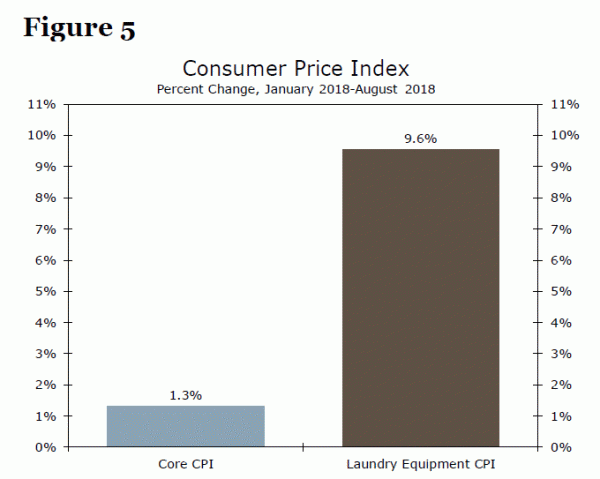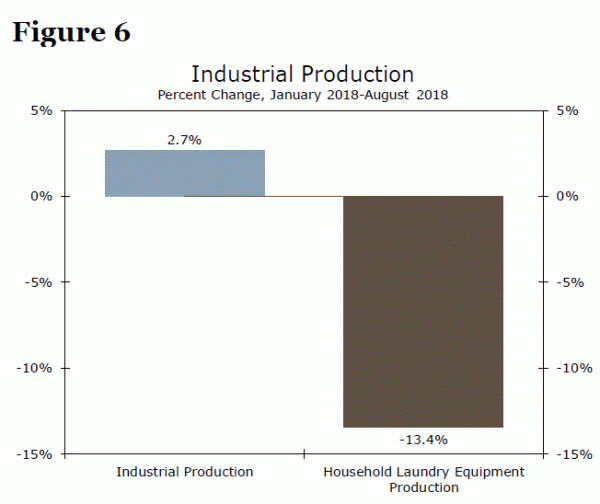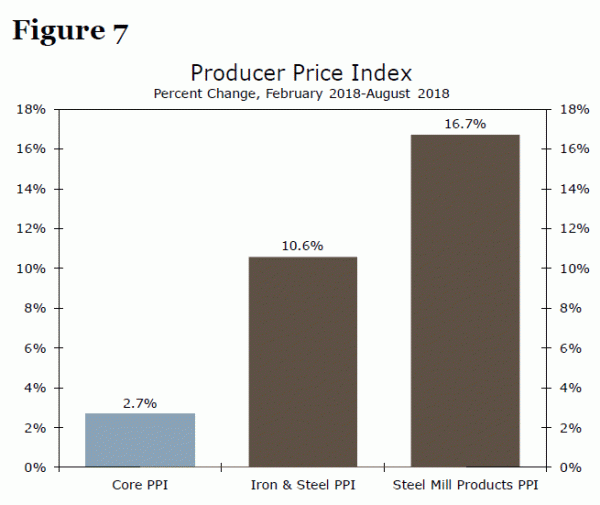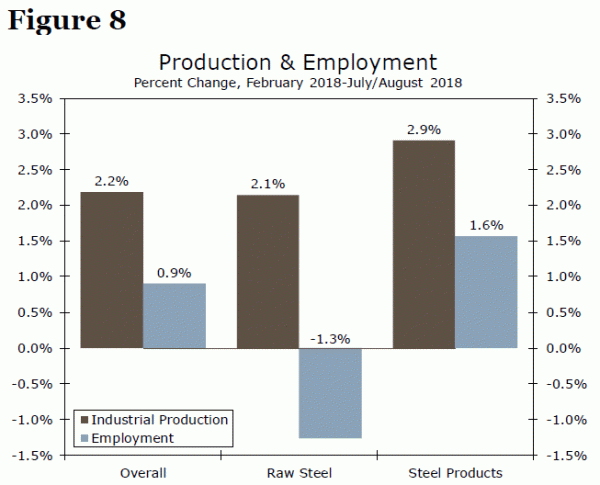Executive Summary
In the first of a two-part series, we analyze the effects that American tariffs on softwood lumber, washing machines and steel have had on prices, output and employment in those industries. The analysis of early data may shed some light on the potential effects that recently enacted tariffs on $200 billion worth of Chinese imports may have on those industries in the United States. Tariffs have raised prices in the affected industries. However, outside of that intuitive point, the conclusions are not perfectly clear cut because we find modestly negative effects on output and employment in some, but not all, of the industries we analyze. Admittedly, it may be too soon for the effects of the levies to be fully reflected in industry output and employment, and we acknowledge that those variables could be affected by factors other than tariffs. We will update our data-based approach to this topic as information becomes available. In the meantime, it may ultimately prove difficult to make sweeping generalizations about the industry-specific effects stemming from levies on $200 billion worth of Chinese imports that have recently been enacted.
Revisiting the Costs of a Trade War
As international trade tensions were beginning to escalate in April, we wrote a report considering how costly a full-blown trade war would be.1 At the time, the United States had announced plans to impose tariffs on $50 billion worth of Chinese imports and China had retaliated in kind. We noted in that report that the business environment would be more challenging for some American industries (Figure 1). But a full-blown trade war, “would not necessarily bring the U.S. economy to its knees, due to the relatively small amount (in terms of overall value added) that the United States exports to China.” Indeed, China has more to lose. The United States sends less than 10% of its exports to China; nearly a fifth of China’s exports are destined for the United States (Figure 2).
But we acknowledged that the overall effect on the U.S. economy could be greater than just the direct effects of the tariffs on exports and imports. That is, there could be indirect “second-order” effects from a trade war. While difficult to measure precisely, some examples of second-order effects include depressed business fixed investment due to uncertainty, a decline in the stock market, which would negatively affect household wealth, and retaliatory selling of U.S. Treasury securities by the Chinese government, which could push up long-term interest rates in the United States.
Nearly six months on, we believe that it is time to re-examine our analysis in light of recent developments. Namely, on September 24, the United States imposed tariffs on another $200 billion worth of Chinese imports, and China retaliated by targeting an additional $60 billion worth of American exports. In the first of a two-part series, we focus on American imports and analyze what has happened to prices, output and employment in industries that have been directly and indirectly affected by higher tariffs. Are there any lessons for the industries that will be affected by the most recent tariffs from the import taxes that have already been enacted? In a follow-up report, we will analyze the effects on U.S. exports from the already enacted Chinese tariffs as well as any fallout from the aforementioned second-order effects.
Early Lessons from Initial Tariffs
The initial forerunners in the current trade skirmish include the tariff on $5.9 billion worth of softwood lumber imports from Canada that was imposed in November 2017, the import tax on washing machines that was levied in February and the tariff on solar panels that also went into effect in February (Table 1). What effects have these trade restrictions had on prices, output and employment in those industries?
Logjam: The Effects of Softwood Lumber Tariffs
The levy on softwood lumber imports from Canada was telegraphed several months in advance. Commerce Secretary Wilbur Ross announced the import taxes in April 2017, seven months before they eventually went into effect. What have been the measurable direct effects of these tariffs, and what might they tell us about the potential effects of the more recent and broader trade restrictions?
In Figure 3, we plot wholesale prices for softwood lumber from the PPI report against the broader measure of the core PPI since the start of 2017. Prices for softwood lumber outpaced the core PPI through 2017, but the former surged in early 2018 as the tariffs kicked in. Although lumber prices have subsequently come off the boil, due in part to some softness in residential construction, it seems obvious that the tariff caused lumber prices to jump more than wholesale prices in general. In a statement articulating its opposition to the latest $200 billion in new levies, the National Association of Homebuilders estimates that the lumber tariffs have added thousands of dollars to the cost of a typical single-family home2. Not only have prices of raw lumber increased, but prices of wood products, which is a “downstream” industry, have risen more than overall wholesale prices—12% versus 7%—since early 2017.
Unfortunately, data on U.S. production of softwood lumber are not readily available. Overall, industrial production (IP) has risen 5.6% since January 2017, while production of wood products, which is a downstream industry, is up by only half that amount (Figure 4). Production of paper (another downstream industry) is down 1.5% over the same period. In short, the tariffs, which raised the price of lumber, may have weighed on production in downstream industries such as wood products and paper, although other factors may have negatively affected production in those industries. Moreover, the levies do not seem to have had an adverse effect on employment in downstream industries, at least not yet. Employment in the wood products industry is up 1.7% since January 2017, which is less than the 2.9% rise in private sector payrolls, while employment in the paper industry has risen 2.5%.
Spin Cycle: The Effects of Washing Machine and Solar Panel Tariffs
Unlike the levies on softwood lumber, which had a long lead-time and consequently a more gradual reaction in economic statistics, the tariffs on washing machines and solar panels were announced at the end of January and went into effect just a few weeks later on February 7. The upshot is that we have a clear starting point for measuring the tariffs’ effects on these two industries. We also have six months of data from which to make some initial assessments of their effect.
Time-series data on prices, output and employment in the solar panel industry are not readily available, but we were able to source some of this data for the laundry equipment industry, which includes washing machines.3 As was the case with the import tax on lumber, the data reveal a significantly higher increase in prices of laundry equipment than the broader measure of consumer prices. Prices for laundry equipment rose about 10% between January and August, which is significantly more than the 1.3% increase for core consumer prices (Figure 5).
So if washing machines are costing households more, is there a bright side? Are we at least making more appliances in the United States than we were before the tariffs? Unfortunately not. As shown in Figure 6, production of household laundry equipment has nosedived more than 13% since the tariffs on washing machines were levied at the end of January, while overall IP has risen 2.7% over that period. Although production of washing machines in the United States may eventually recover, the short-run effects of the tariffs on those products seem to have lifted prices while depressing production. Data on employment in the washing machine industry or in the broader laundry equipment industry are not readily available, but a significant increase in payrolls in these industries does not seem very likely in light of the nosedive in production that has occurred in the laundry equipment industry.
Paying the Iron Price: Effects of Iron and Steel Tariffs
Imports of softwood lumber, washing machines and solar panels total about $16 billion, which represents less than 1% of total imports. The administration has also levied tariffs on steel and aluminum, imports of which total about $40 billion (1.7% of total imports). Although a bit more meaningful in terms of overall imports, the levies on steel and aluminum have not been in effect as long as the tariffs on lumber, washing machines and solar panels, which gives us a shorter timeframe to assess their effects. The levies on steel and aluminum tariffs went into effect the last week in March, at least nominally. Carve-out exemptions applied to a number of U.S. trading partners until those measures expired on May 31. So one could reasonably argue the steel and aluminum tariffs did not go into full effect until June, but the effects of those trade restrictions have been unmistakable ever since March.
Between February and August, the core PPI rose 2.7%, but iron and steel prices are up nearly 11% over that period (Figure 7). But this significant increase in iron and steel prices does not seem to have had much of a stimulative effect on domestic production of those goods, as theory suggests that it should. Since February (the month before the tariffs started to go into effect), domestic production of steel is up 2.1%, which is in line with the increase in overall IP (Figure 8). Despite this increase in production, however, employment in the raw steel industry is down 1.3% since February, an extension of a decades-long decline that may have as much or more to do with automation as it does with globalization. About 86,000 individuals work in iron and steel mills in the United States today, roughly half of the number of workers employed in that industry in 1990.
Moving downstream to the steel products industry, which makes goods from raw steel, price are up a whopping 17% since February (Figure 7). But despite this significant increase in input costs, production in the steel products industry has outpaced the increase in overall IP, while employment in the industry has risen more than total private sector employment since February (Figure 8).
Can We Say Anything Conclusive About Effects of Tariffs?
The administration also imposed tariffs on a variety of Chinese goods, whose value totals $50 billion (Table 1), but these levies have not been in place long enough yet to allow us to say anything meaningful about their effects. So can we say anything in general about the effects that tariffs have had on prices, output and employment in the lumber, washing machine and steel industries? Are there any general lessons that we can learn that are applicable to other industries that recently received tariff protection?
What is clear is that tariffs raise prices in the affected industries more than the general price level, which is probably an obvious point. Prices of softwood lumber, washing machines and steel have all moved significantly higher than overall wholesale prices or consumer prices since the imposition of tariffs on those industries. But the effects on output and employment are less clear. Whereas output in the laundry appliance industries tanked after import taxes were imposed on washing machines, output in the steel industry seems to have been little affected, at least so far. The employment record is mixed as well. Output and employment in specific industries have been affected by factors other than tariffs. Moreover, the levies did not go into effect until recently, so maybe it is just too soon to make general conclusions about the effects of specific tariffs.
Conclusion
The administration has enacted tariffs on more than $300 billion worth of imports since last November. However, levies have been in place long enough to allow us to say something meaningful about their effects on only $56 billion of these imports. By definition, tariffs clearly raise the domestic price of the goods in the affected industries. Outside of that intuitive point, we find modestly negative effects on output in some, but not all, of the industries that we analyze. We acknowledge that it may still be too soon for the effects of the tariffs to be fully reflected in industry output and employment, and we recognize that those variables are affected by factors other than just tariffs. Therefore, it may ultimately prove difficult to make sweeping generalizations about the industry-specific effects stemming from levies on $200 billion worth of Chinese imports that have recently been enacted.
When we wrote our initial report six months ago, we concluded that the “first order” effects of a trade war would not be large enough to push the U.S. economy into recession. We stand by that conclusion. However, it also seems that the first order effects on the industries that received tariff protection are modestly negative, at least so far. In the September ISM survey, four individual respondents cited the tariffs as a hindrance to their business or industry. We will continue to monitor developments to see if we can eventually draw more meaningful conclusions. In the meantime, we will turn our attention to the “second order” effects of American tariffs and the effect of Chinese levies on U.S. exports. We will detail our conclusions about those effects soon in a followup report.




